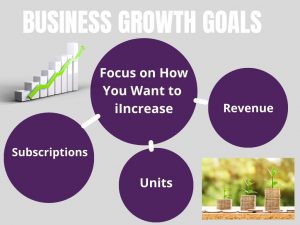If the business you’ve started is small, the only way to go from there is up, right? If you put in the work, you’re bound to grow from a tiny seed of an organization to a flourishing one! Unfortunately, it’s just not always that simple. And you might be thinking, “I don’t need (or want) to be the head of a huge corporation, so do I really need to worry that I’m not growing as much as I’d like right now?” Well, here’s the thing: if you’re not growing, you could end up stuck in an uncomfortable spot between being the owner of a very small business and a very large one. Being wedged in there means that you’re probably going to be doing all the work to keep things running, while still not seeing much of a return. So it might be time to examine why you’re stuck where you are, and look for solutions to your problem of stagnant growth.
Going in Without a Plan

When experts tell you you need a solid business strategy, listen. Your business strategy should include a clear set of plans, actions and goals that outlines how your business is going to compete in your market – and it needs to be written down! If you haven’t done this, you’re basically jumping in with a “fire, aim, ready” approach, hoping that you’re somehow going to achieve your goals.
And speaking of goals, it seems like a lot of small business owners are treating them as simply a buzzword, which can be a huge mistake. According to the Staples National Small Business Survey, 80% of small business owners don’t keep track of their goals! And, you know what, it turns out that, according to some studies, 77% of small business owners fail to achieve their visions. Think those stats might be related?
The solution, according to a Dominican University study, seems to be writing down your goals and making yourself accountable. In the study, 5 groups of business owners set goals and followed increasingly detailed steps; for example, group 1 only thought about their goals, while group 5 wrote their goals down, rated them, formulated actions, and sent their plans to a supportive friend along with weekly progress reports. The result? 76% of participants in group 5 achieved their goals, or were at least halfway there.
“Growing” It Alone
We’ve already covered how you should never ignore advice about creating your business strategy and setting goals, but the same goes for any advice that you’ve sought from trusted sources. We get that you’re protective about the way you run your business, but sometimes you need to hear straight talk from someone who’s been there.
And ignoring sound advice isn’t the only problematic way for you to go it alone. There’s a whole community of entrepreneurs out there, all at different stages of their business journeys that you could be speaking to. We’re not saying you have to seek out and fraternize with the competition; what we are saying is that interacting with like-minded business owners in any field can foster creativity, help you identify blind spots, and build self-confidence.
Not Having the Right Team

Not seeking advice from pros or talking to your peers can hold you back, and so can trying to do all of the day-to-day work of your business alone. You might be a one-man band when you first start your business, but if you want to grow, you’re going to need to hire a team, or at least outsource some of your tasks. No one can do everything – and even if you think you have 25 hours in the day to get everything done, remember that no one can do everything well! You’ll need to set up a process for hiring and training high-quality employees, and you’ll need to be comfortable with making changes in your team as needed along the way.
Lack of Investment
Growing businesses are like cash vacuums. As you grow, you might need to invest in new technology, a bigger space, more employees, or more equipment, and that means constantly finding ways to pump cash into your business. That could mean seeking out more investors, applying for business loans, or using up any cash you have on hand. If that sounds exhausting, well, it can be – and if you choose to jump off that hamster wheel for a while, you could find that the growth of your business slows down.
Cutting Corners
Yes, it’s tough getting the constant flow of cash that your business needs. But that doesn’t mean you should be pinching pennies at every opportunity. For example, hiring inexperienced vendors, not investing in necessary technology, not putting in the resources necessary to hire the right staff, or skimping on health and safety can all come back to bite you, and could end up costing you more in the long run. Instead, try cost-cutting (not corner-cutting!) strategies like negotiating with your landlord or vendors or outsourcing or making some employees remote.
Having the Wrong Attitude Towards Customers
Since we’re talking about cutting corners, another thing that should never fall by the wayside is customer support. No customers, no business, right? But it can be easy for them to get lost in the shuffle with all of these other considerations. Make sure that everyone associated with your business always treats customers with respect and never dismisses them as impossible to please. Because you know what? Even “difficult” customers have lots of friends and family, and word can travel fast. Remember, dissatisfied customers will tell between 9 and 15 people about their negative experience!
Ignoring Branding, or Failing to “Look the Part”
One more thing you shouldn’t skimp on? Branding. And that’s not to be confused with a marketing strategy; you need to think about branding your business, or establishing a powerful message surrounding your business, before you can begin spreading that message. Remember, your messaging will determine if your message actually gets seen. You need to have a compelling message that proves to your prospective clients or customers that your product or service is the solution to their problem.
Looking the part goes hand-in-hand with creating the right brand and message. And what do we mean by “looking the part?” Well, think of it this way, if you want prospective clients or customers to take you seriously, you have to project the right image. That means not making your business look amateurish with a poorly designed logo, a low-quality, DIY website, or inactive social media accounts.
Once you’ve gotten a handle on your brand, then you can begin to implement an effective marketing strategy, which should include social media marketing, SEO, content marketing, and email marketing.
Undervaluing Your Product or Service
If you’re afraid of overpricing your products or services, you could end up underpricing them. Sure, when you first start out you might want to competitively price your products or services to attract customers, but as you get more established, you should reflect your know-how, experience, or the quality of your products in your prices. Overcome fear-based pricing; remember, when you declare the value of your products or services, that is the value people believe it has.
When it comes to small businesses, growth is never a guarantee. It takes hard work, reaching out, and taking risks. It also takes constantly evaluating what you’re doing, recognizing the mistakes you’re making and having the ability to change course. Use the above tips to help you get that critical eye, and move forward towards your goals!


